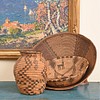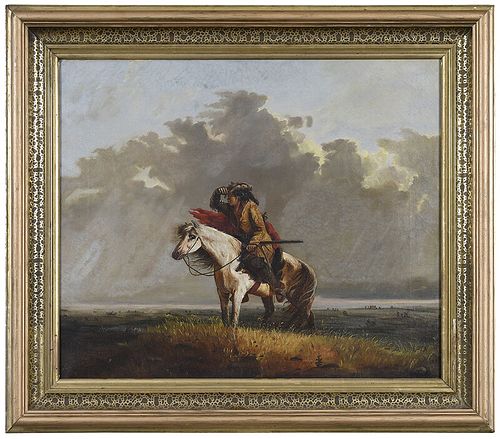(American, 1810-1874) The Lost Greenhorn,ÿsigned with initials and dated lower right, ?J.C.H. 1870", oil on canvas, 20 x 24 in.; period carved gilt wood and composition frame, 26-1/4 x 30 in.ÿ - Provenance: Private Florida Collection - Note: Possibly painted by John Hovey (born 1811) , this painting is after Alfred Jacob Miller's iconic work The Lost Greenhorn, a subject he painted numerous times between 1850 and 1866.ÿ This copy appears most like the 1851 version of this subject, in the collection of the American Museum of Western Art, cat. #147A, which was produced as a chromolithograph by Miller that year and published by H. Ward Jr. in New York.ÿÿIn 1851, Miller produced a chromolithograph ofÿThe Lost Greenhornÿwith the printmaker H. Ward, Jr. in New York. It was copied from what is probably the first oil on canvas of this popular work, this version of the painting. This suggests that Miller, from the start of exploring this theme, wished the image to have wide circulation. It was, perhaps, his effort to compete with William Ranney whose painting, Trapper?s Last Shot, had won accolades at the American Art Union in New York and the Western Art Union in Cincinnati the year before, and was reproduced as a broadly distributed steel plate engraving. Although the narratives are different, the Miller and Ranney paintings share much in common compositionally and in emotional impact.Miller started to exhibit at the American Art Union in 1851, the same year he produced this first version ofÿThe Lost Green Horn. It was exhibited at the Pennsylvania Academy of the Fine Arts in 1852. He had turned more toward mountain man scenes after the mid-1840s (Tyler, 1999, 37) and, though this is not a mountain man picture per se, a lost greenhorn on the prairie would conform to the fresh direction in which he was headed with his art.Peter H. Hassrickÿ ÿ ÿ ÿ ÿ ÿ ÿ ÿ ÿ ÿ ÿ ÿ ÿ ÿ ÿ ÿ ÿ ÿÿÿ
Condition
crackle, stretcher marks, areas of fluorescence, surface dirt layer; frame with wear










